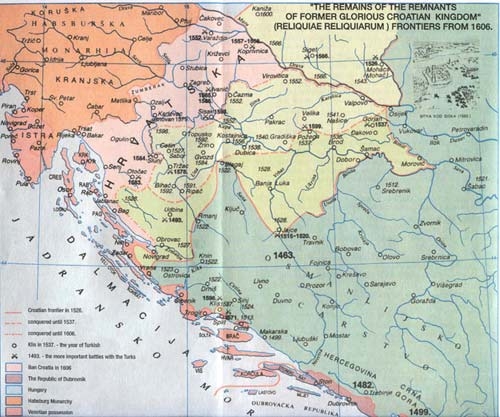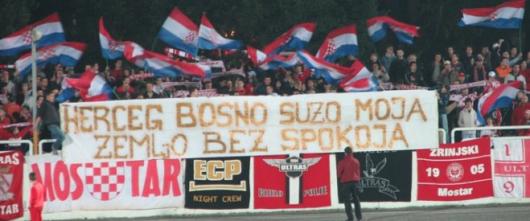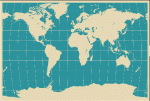Web catalog
Most read
Most read last 7 days
Most Discussed
Top rated
Statistics
- Total registered users: 9886
- Total articles: 23656
- Total comments: 2087
- Last entry: Kebo presenting evidence that Izetbegovic brought mujahideen to Bosnia
- Last update: 11.01.2019. 23:44
Ottoman Rule: Invasion, Conquest and Intermittent Warfare (1463 - 1878)

1463.
In a medieval Blitzkrieg, during May and June, after almost eight decades of systematic devastation and conquest, the Turks have conquered Bosnian kingdom.
After they have promised a fifteen years long armistice to the emissaries of the Bosnian king Stjepan Tomasevic, huge Turkish army numbering about 150.000 men has during the first half of May departed from Drinopolje and through Skoplje, Kosovo and Sjenica slashed through the borders of Bosnian kingdom, and through Podrinje has broken into the central and upper Bosnia. The fortress of Bobovac, besieged on May 19, has capitulated to the Turks on May 21. In front of the danger from the Turks, king Tomasevic has sheltered himself in Jajce, wherefrom he started for Croatia, hoping to raise some help, but he was besieged in Kljuc on the river of Sana. Since Mahmud-pasa Andjelovic has promised to the king Tomasevic the safety of life and the freedom, the king
surrendered to the Turks.In that way the Turkish conquerors have conquered in short time the three most important Bosnian cities: Bobovac, Jajce and Kljuc, and after that, under the pressure and by the king's command, the rest of Bosnian cities have laid the arms to the Turks. According to the annalist Dlugos, seventy Bosnian cities surrendered to the Turks; according to one Italian report this number was 117, and according to Christobal--somewhat less than 300. According to various data, the Turks have thereafter captured about 100,000 people, and recruited about 30.000 young men (these Turkish soldiers were afterwards known as "janjicari/yannisaries"- the term being derived from Turkish words "yeni" (new) and "ceri" (army)). The Turkish attempt to conquer Hercegovina failed. Not a single one of the neighbouring states has given some help to imperiled Bosnia. The personal attempt from the Pope Pius II to call for a crusade for the
liberation of Bosnia was ended by his death in Ancona on July 19. The king Tomasevic was executed in Jajce, after he had commanded the surrender of his cities to the Turkish conqueror.
1463.
In Milodraza, between Fojnica and Visoko, the Turkish sultan Mehmed II The Conqueror --at a fra. Andelo Zvizdovic request, who demanded freedom of religious activities and free confession of faith for Bosnian Catholics - has issued a solemn charter-- Ahd-nama -- by which he guaranteed the freedom of activities to the Franciscans "in my empire", the free return of expelled Franciscans, and: "Neither my High Majesty, nor my viziers, nor my oficials, nor my subjects, nor any dweller of my empire should give offence to and disturb them. No one should attack them, or offend and threaten them: neither them nor their lives, nor their property, nor their churches. And moreover, if they bring on
someone from the foreign parts to my state, let them be allowed..." It was a kind of an international document by which the peace and freedom was guaranteed to the Bosnian Franciscans and Catholics "till they will be obedient to my service and faithful to my Command". Such a freedom and peace, the Franciscans and the Catholics in Bosnia will have enjoyed, relatively, till the twenties of XV century.
1463.- 1600.
Circa 300,000 Catholics converted to Islam in Bosnia and Hercegovina.
1516.
According to the first Ottoman Statute of Bosnian Sanjak/province: "We are informed that some Christian churches have been erected where there were none in the past infidels era. These churhes are to be razed; and those infidels and priests, who, dwelling in these places, spy and inform our adversaries in infidels's lands, are to be severely physically punished (siyaset). Let the crosses erected by the roadside be smashed, and none be reinstated again- ever ! And if they put the crosses up again- let them be punished bodily. And that Qadi (Islamic judge), who has condoned such an abomination- we shall dismiss and punish him, too." This is the 1st official instutute enabling legal persecution of Croats Catholics in the Bosnian Sanjak. The aforementioned Statute sanctioned intensified pogroms of Catholics in the western parts of the Ottoman Empire (vastation of monasteries and sacral objects, maltreatment and murder of priests and Catholic Christian laity). The law has been reaffirmed in 1530. , 1539., 1542.
1520.
Croatian Ban and "defendor Croatiae", bishop Petar Berislavic was killed in a Turkish ambush near the Devil's Mountain in the Bihac area (now, the northwestern Bosnia); "... and Turks murdered Croatian Ban, Peter the bishop, near Bihac in the Devil's Mount, in the Devil's Grotto. And they severed his head. And the Bihac citizen Pavao Medosic found his head and his body, and brought them in Bihac."
1523.
Krsto Frankopan delivered an impassioned plea before the Pope Hadrianus, emphasizing the importance of Croatia as the rampart against the Ottoman avalanche: " Holy Father- in Croatia, one can see, one is forced to see bestial slaughter of children before their parents's eyes and husbands before their wives's eyes. Women are being dishonoured, virgins raped, sacred places desecrated. Croatia is, Holy Father, rampart and entry of Christianity, and especially the rimlands of Carinthia, Istria, Furlania and Italy. Should Croatia-God forbid !- fall- then, all the ghastly and beastly tortures threaten these lands and the road towards them will be unhindered and free for Turks..."
1524.
The fiercest pogroms of Croat Catholics in Bosnia and Hercegovina. Franciscan monasteries in Kraljeva Sutjeska, Viskoko, Fojnica and Konjic are razed to the ground (the Mostar monastery met the same fate later.) Between 120-150,000 Catholics forcibly converted to Islam.
1525.
Krsto Frankopan, one of the most notable European soldiers of fortune of these times, has passed through the Turkish lines to relieve the besieged Bosnian Croat city of Jajce, which resisted the Ottoman siege for more than a year and half. He was prompted upon hearing the story from a refugee from Jajce, a certain Jure Mrsic, that a mother in Jajce had thrown her baby boy into the Vrbas river because she couldn't bear to see him die from starvation. After two days of breaking through Turksih positions, Frankopan entered with 6,000 soldiers into the city and brought the supplies in. Jajce managed to resist for another three and a half years.
1528.
Turks have conquered Jajce and Banja Luka, thereby completely destroying Croatian defence line on the Vrbas river. Croatia was reduced to 37,000 square kilometers.
1530.
A Slovene monk, Benedikt Kuripesic has, in a diplomatic mission, journeyed through Bosnia, leaving valuable annotations on ethnic and confessional situation in the contemporary Bosnia: " In this kingdom we have found three peoples and three faiths. First- there are indigenous Bosnians, who are of Roman-Christian denomination. Then, there are Serbs, who are called Wallachians, and we call them Chichs or Martologes. They came from the city of Smederevo and Greek Orthodox Belgrade, and belong to the Saint Paul's faith (Orthodox)....The third people are Turks. They, and soldiers and officials in particular, behave tyranically towards both aforementioned peoples, Christian subjects...". Kuripesic published his travels in Augsburg 1531.
1533.
According to Venetian patrician Sanudius, the author of "Diario", Turks have, from Croatian lands, taken 600,000 men and women into slavery to date.
1563.-1631.
Matija Divkovic, Bosnian Franciscan and Croatian writer, the author of numerous books printed in Venice in "bosancica", Croatian cyrillic script.
1569.-1577.
Turkish historian Mustafa aali, a native of Gallipolli, wrote on Bosnia: "...So far as the tribe of Croats, who are ascribed to the Bosnia river, is considered: their character is reflected in joyous nature; they are known in Bosnia and named after flowing waters.."
1593.
Great victory of Croat and Christian armies over Turks in the Sisak battle, July the 22nd. Near the border city of Sisak, 5,000 Croats under the command of Croatian ban Toma Erdody, aided by Slovenian reinforcements from Carinthia and Styria, have broken the Turkish surround of circa 12,000 men and pushed them towards the Kupa river, constantly pounding them with heavy artillery fire. Caught in the middle between two Christian army flanks, Turks panicked and started a chaotic retreat. Having disintegrated under the unending cannonade, the bulk of the army (circa 10,000 men, with all the chief commanders) drowned in the Kupa river. Christian losses numbered between 40-50 men. Although this battle was the ouverture to the so-called "Long war" (1593.-1606.), it marked, along with the Siget (1566.) and the Lepant (1571.) battles, the change of war fortune in the Ottoman-European wars.
ca. 1600.-1685.
Ivan Ancic, a Bosnian Franciscan and theologian. Writer of Latin and Croatian language treatises.
1611.
Fra Matija Divkovic, a Franciscan intellectual, published "Nauk karstianski"/Christian doctrine in Venice. This is the first
printed work of a Bosnian writer in Croatian language; reprinted
thirteen times (not counting abridged versions.)
1624.
According to the Papal visitator Peter Masarecchi's notes, circa
40-50,000 Croat Catholics have converted to Islam in the central Bosnia.
1627.
Bishop Andrijasevic in Trebinje region (eastern Hercegovina) writes on the conversion of Croat Catholics into Serbian Orthodoxy. His data show that out of 12 Catholic churhes in the region, 7 had "passed into Orthodox hands".
1663.-1664.
Habsburg-Turkish war, or the 1st Turkish war, fought over Erdely in the south Hungary area, where brothers Zrinski achieved particular prominence. During the Fall of 1663. Croatian Ban Nikola Zrinski has with 300 cavalrymen defeated 2,000 Tartars near the Mura river, while his brother Petar, commanding 2,500 soldiers, crushed the 10,000 men strong Turkish army in the Lika region in Croatia, capturing its chief commander Bosnian Muslim pasha Alija Cengic. Following other military successes, Ban Nikola Zrinski has launched sustained military campaign, capturing many Turkish fortresses and burning famous Osijek bridge, the gateway of Ottoman armies on their raids into central Europe. However, even after the defeat of Turkish forces at St.Gotthard, cowardly Viennese court, fearing the possible unstoppable rise of powerful Croatian and Hungarian nobility (which would certainly endanger the Habsburg project of centralized absolutism), made a humiliating peace treaty with the Ottomans in Vasvar. Since Croatian and Hungarian lords expected final liberation of Croatian and Hungarian territories still under Turkish occupation, this Habsburg-orchestrated defeatist treaty embittered even more relations between them and the Viennese court.
1682.-1729.
Lovro Sitovic Ljubusak: a Franciscan, preacher, professor and writer.
1683.-1699.
Turkish army numbering 250,000 soldiers set the siege of Vienna on the August the 13th 1683. The siege was relieved with the help of Polish king Jan Sobjeski and Turks suffered a crushing defeat at the Kalenberg field, September the 12th. This event triggered general uprising of Christian masses in Croatian and Hungarian lands under the Ottoman rule. The ensuing warfare ousted Turks out of Lika and Slavonia regions in Croatia, as well as from Hungary and Transylvania. The Croatian military border with Ottoman Empire went along Una and Sava rivers.
1696.
During Habsburg-Turkish war (1683.-1699.), according to the Franciscan Andrija Siprasic's testimony, more than 100,000 Bosnian Croats have, fleeing the Turkish oppression, crossed the Una and Sava rivers and found refuge in Croatia.
1697.
Habsburg commander, Field Marshall prince Eugene of Savoia, crossed the Sava river with 6,500 soldiers, 12 small cannons and 2 merzers. Having met little or no resistance (considering that Frankopan's troops sent desperately to relieve the siege of Jajce, some 170 years before, consisted of roughly the same number, one can see how the Ottoman force has spent itself), prince Eugene reached Sarajevo in 11 days, took it, plundered and burnt it , and then returned to Osijek. Fearing Turkish reprisals, circa 40,000 Croat Catholics left Bosnia with his army.
1700.-1783.
Fra Filip Lastric, professor and educator, provincial of Franciscan province Bosnia Argentina, writer and historian.
1723.
According to demographic estimates there are 25,000 Croat Catholics in Bosnia and Hercegovina
1737.-1739.
The Habsburg-Ottoman war by which the Habsburgs have lost everything they had acquired in Bosnia, Serbia and Wallachia in the 1716.-1718. campaign. The river Sava became a border between Croatia and Turkey.
1743.
According to the census made by apostolic vicar the bishop Pavao Dragicevic, Bosnian vicariate numbered 39,831 Catholics (the diocese of Trebinje not included).
1765.
The work of fra Filip Lastric "Epitome vetustatum provinciae bosniensis" (A Survey of Antiques of the Bosnian Province) printed in Venice. This work is considered the beginning of the modern historiography in Bosnia-Herzegovina.
1788.-1791.
The Habsburg-Turkish war, into which the Monarchy was drifted as a Russia's ally. The Monarchy amassed 245,000 men and 1,150 cannons. The Austrian army got stuck in the five-months siege of Bosanska Dubica fortress, which nowadays is the border between Croatia and Bosnia. The Viennese Court, which entered the war with a plan to get back what was lost in 1739., despite isolated successes, like the penetration in the major part of Bosnia, was out of luck again. The only territorial gain was the inclusion of the parts of present-day Lika and Kordun into Croatia.
1791.-1815.
The "boundaries redrawing" period in and around Bosnia under the influence of the French revolution and the Napoleonic Empire. After short-lived "Illyrian provincies", the restoration of the Austrian administration in the continental Croatia and Dalmatia. East to Bosnia, the uprising against Ottoman Empire broke out in Serbia, in which the Serbian forces, after initial successes (the Turkish army faced a defeat on several occasions) and general national liberation war in which the local Muslim population was expelled mostly into Bosnia, have succumbed to decay and disintegration. However, by Sultan's recognition of autonomy of Smederevo Sanjak in 1815., the foundations of the Serbian state have been laid.
1815.-1878.
The general decline of the Ottoman authority in Bosnia-Herzegovina. After the reorganization of the army (the destruction of the yannissary corps), signs of revolt appear among Muslim aristocracy in Bosnia (traditionally connected to this military unit), as well as the uprising of the local captains in command (the most spectacular being the northern-Bosnia based unsuccessful rebellion of captain Husein, who has with his army of 25,000 men tried to extort the foundation of Bosnian autonomy under the rule of the local Muslim nobility, as well as the discontinuance of social reforms). In the period of several decades the Ottoman Empire has undertaken a number of reforms with the aim to make real religious freedom, which provoked the resistance of Bosnian Muslim aristocracy and even greater antagonism and separation of Christian and Muslim populations. However, due to general economic decline, the pressures from Muslim traditionalists, badly organized administration, as well as growing national self-confidence, especially of Christian inhabitants--the Ottoman 'perestroika' has, like her Soviet heiress, only sped up the collapse from within a rotten system.
1818.-1857.
Ivan Frano Jukic, the Bosnian Franciscan, a writer, a follower of the Croatian national revival and a sufferer in Turkish gaols.
1822.-1905.
Grga Martic, the Bosnian Franciscan, a propagator of education and schooling, a politician, a fighter for union of Bosnia-Herzegovina with Croatia, one of Croatian revivalists, and a poet. His verses:"Woe to a home without fraternal bliss, woe to Bosnia that gives Croatia a miss", are especially known.
1823.-1896.
Ante Starcevic, a scrivener at scriptorium of the Zagrebian lawyer Schram, the first modern translator of the Holy Scriptures and Anacreon, a philosophical and political writer, a public representative, a co-founder of the Party of Rigts, the most celebrated Croatian ideologue and politician, the creator of the Croatian national idea and nationhood, an intercessor for the universal civic rights. The father of the homeland. The Party of Rights would become the major political force among BH Croats during the Austrian administration in Bosnia-Herzegovina (1879.-1918.).
1875.
In lower Herzegovina, in the Gabela and Hrasno district, under the leadership of don Ivan Music, Croats have, ignited by overtaxing, rebelled against Turkish authorities on June the 19th. Very soon after, in east Herzegovina, the Serbs rebelled too, and after that the rebellion of the whole Christian population of Bosnia-Herzegovina followed. The Turkish authorities couldn't put down the uprising so that Serbia and Montenegro (1876.), and Russia (1877.) were sucked into the war--the fighting having ended at 1878. During the war, more than 150,000 people took refuge in Croatia.
Related articles
- Early Medieval Age: Birth of a Region (c. 600 - 1180)
- Mature Medieval Period: Integration, Expansion and Dissolution (1180 - 1463)
- Austro-Hungarian Rule: Tutorship and Westernization (1878 - 1918)
- Royal Yugoslavia: The Winter of Our Discontent (1918 - 1941)
- World War 2: Heart of Darkness (1941 - 1945)
- Archive of related articles

























































 Kontaktirajte nas
Kontaktirajte nas
No comments